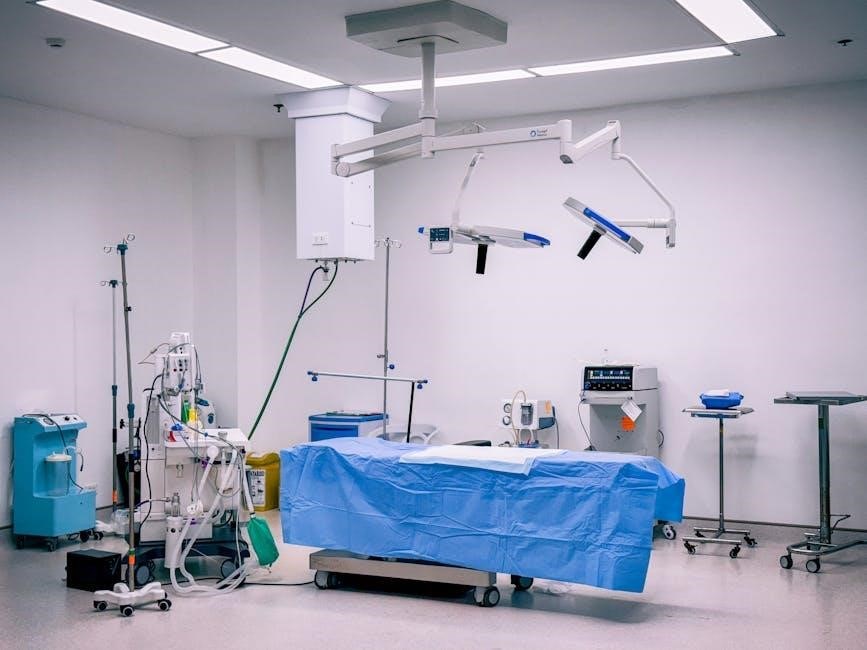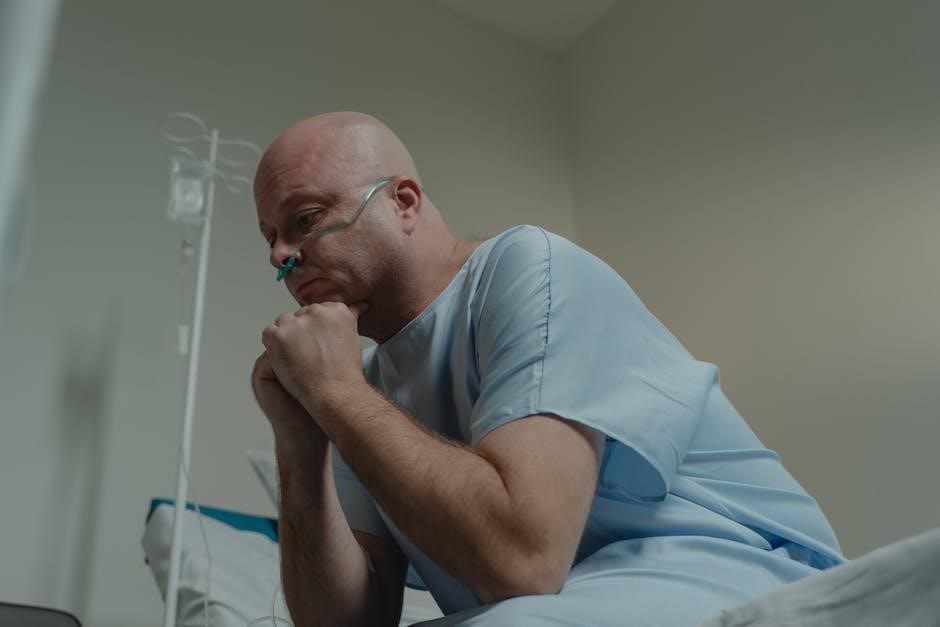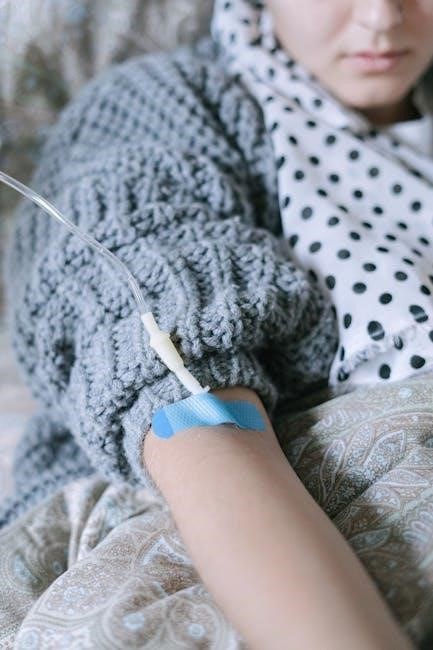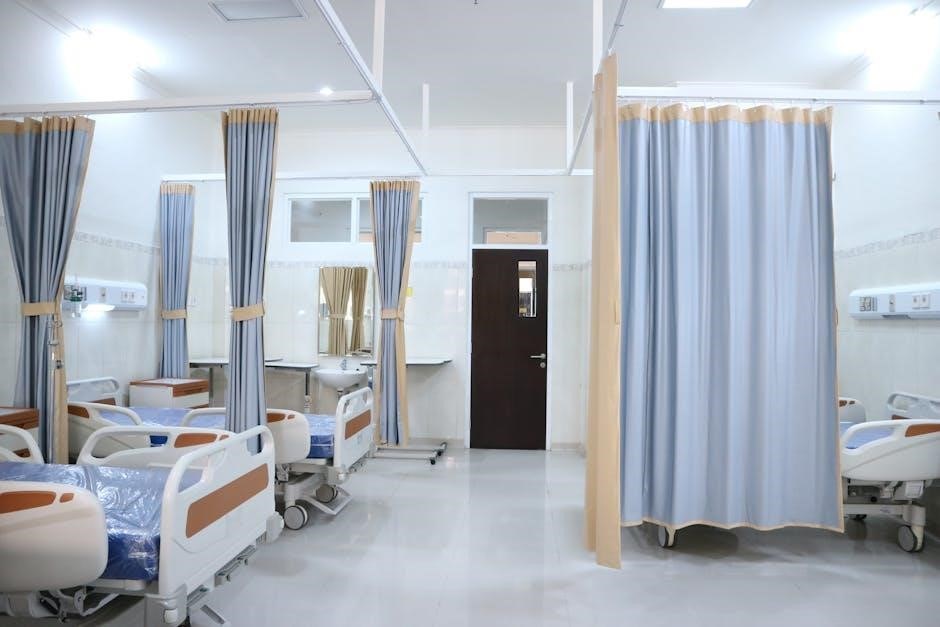The Invacare hospital bed is designed for medical settings, offering adjustable height, side rails, and a robust mattress support system. Ideal for patient care in both home and professional environments under supervised medical monitoring. Durable, safe, and easy to maintain, it ensures optimal comfort and support for patients.

Safety Precautions
Ensure safety by following guidelines in the Invacare hospital bed manual. Adhere to weight limits, prevent entrapment by centering the mattress, and use proper transport methods. Always check all components before use.
2.1 Weight Limits
The Invacare 36-inch wide Manual/Electric bed has a total weight limit of 450 pounds, including the mattress, occupant, and any additional accessories or objects. Exceeding this limit can compromise safety and damage the bed. Always ensure the bed is used within the specified weight capacity to prevent potential injuries or structural failure. Regularly inspect the bed for any signs of overload stress, such as uneven support or frame warping. For bariatric models, refer to specific guidelines provided in the user manual. Adhering to weight limits ensures optimal performance and longevity of the bed, while maintaining patient safety and comfort. Proper loading is crucial for the bed’s functionality and durability.
2.2 Entrapment Risks
Entrapment risks are a critical safety concern when using the Invacare hospital bed. To minimize these risks, ensure the mattress is centered on the bed frame, as misalignment can create gaps between the bed rail and frame, potentially trapping individuals. Always follow the manufacturer’s guidelines for proper bed rail installation and adjustment. Invacare provides specific warnings and recommendations in the user manual to address entrapment hazards. Regularly inspect the bed for any loose or damaged components that could increase the risk of entrapment. Additionally, caregivers should monitor patients, especially those with limited mobility, to prevent accidental entrapment. Refer to the Bed Rail Entrapment Risk Notification Guide available at www.invacare.com for detailed safety protocols and preventive measures. Proper usage and maintenance are essential to ensure patient safety and prevent potential harm.
2.3 Transport Guidelines
Transporting the Invacare hospital bed requires careful adherence to guidelines to ensure safety and prevent damage. Always use approved patient transport equipment when moving patients in the bed. The bed’s weight limit includes the mattress, accessories, and occupant, so never exceed this limit during transport. Ensure the bed is properly assembled and that all side rails are securely locked in place before moving. For manual or electric beds, refer to the user manual for specific instructions on transport preparation. Invacare recommends that only authorized personnel handle the transport to avoid accidents. Additionally, ensure the bed is on a level surface and use appropriate lifting devices if necessary. Regularly check the bed’s casters and brakes for proper function to ensure smooth and safe movement. Proper transport practices help maintain the bed’s durability and ensure patient safety during transfers.

Product Features
The Invacare hospital bed is an electrically operated, height-adjustable bed designed for medical care in supervised settings. It features side rail gliders and a robust mattress support system for optimal patient comfort and safety.
3.1 Types of Beds
Invacare offers a variety of bed models to meet specific patient needs. These include manual, semi-electric, and full-electric beds. Manual beds are cost-effective and suitable for basic care, while semi-electric beds allow for easy height adjustment. Full-electric beds offer advanced features like articulation of head and foot sections. Additionally, bariatric beds are available for heavier patients, ensuring safety and support. Each model is designed with durability and patient comfort in mind, catering to different clinical requirements and homecare settings. The range ensures that healthcare providers can choose the most appropriate bed based on patient needs, whether for acute care or long-term use. This versatility makes Invacare beds a reliable choice in medical environments.

3.2 Adjustable Height
The Invacare hospital bed features an adjustable height function, enhancing patient comfort and caregiver efficiency. Electric models, such as the CS8, allow smooth height adjustments using a control panel, while manual beds may require physical adjustment. This feature facilitates easier patient transfers, improves accessibility, and accommodates different care settings. The bed can typically be lowered to a minimum height for safe patient entry and raised to a comfortable working height for healthcare providers; Proper height adjustment ensures optimal support and reduces the risk of strain during patient care. Always ensure the bed is on a level surface and use the brakes when adjusting height to maintain stability. Regular maintenance, such as lubricating moving parts, ensures the height adjustment mechanism operates smoothly. This feature is a key advantage of Invacare beds, providing flexibility and adaptability in various clinical environments.
3.3 Side Rail Gliders
The Invacare hospital bed incorporates side rail gliders to ensure smooth and safe operation of the bed’s side rails. These gliders are designed to facilitate easy movement of the rails, allowing caregivers to adjust them as needed without resistance. Proper alignment and lubrication of the gliders are crucial for maintaining the integrity of the bed’s safety features. Regular maintenance, such as cleaning and lubricating the gliders, ensures the rails move effortlessly, reducing the risk of mechanical failure. The side rail gliders also play a role in preventing entrapment risks by ensuring the rails align correctly with the bed frame. This feature enhances patient safety and provides peace of mind for both caregivers and users. Always refer to the user manual for specific instructions on maintaining and adjusting the side rail gliders for optimal performance.
3.4 Mattress Support System
The Invacare hospital bed features a robust mattress support system designed to provide optimal comfort and support for patients. This system includes a durable frame and deck that ensure even weight distribution and prevent mattress sagging. It is compatible with a variety of mattress types, including foam, innerspring, and pressure-relieving options, allowing for customization based on patient needs. The support system also allows for articulation of the head and foot sections, enabling caregivers to adjust the bed to various positions for patient comfort. Proper installation and maintenance of the mattress support system are essential to ensure safety and functionality. Always center the mattress on the bed frame to prevent entrapment risks and follow weight capacity guidelines to avoid structural compromise. Regular checks and lubrication of moving parts are recommended to maintain smooth operation. This system is integral to the bed’s performance and patient care quality, ensuring reliability and durability over time.

Assembly and Installation
Assembly and installation of the Invacare hospital bed require following the step-by-step guide in the user manual. Ensure all parts are securely attached and guidelines are followed for safety and proper function. Always refer to the instruction sheet for specific parts like couplings to avoid errors and ensure durability.

4.1 Step-by-Step Assembly
Begin by gathering all components and tools specified in the user manual. First, attach the bed frame to the mattress support platform, ensuring proper alignment. Next, install the side rails using the provided grub screws to secure them firmly. Adjust the angle between the bed end frame and the mattress support platform for a precise fit, as outlined in the manual. Then, connect the electrical components if applicable, following the wiring diagram. After assembling the main structure, attach any accessories like bed rails or gliders. Double-check all connections and ensure the bed is level. Finally, test the bed’s functionality, including height adjustment and articulation features. Refer to the instruction sheet for coupling replacements or other specific parts. Always follow the manual’s guidelines to ensure safety and proper assembly. For additional assistance, download the Coupling Replacement instruction sheet from Invacare’s website.
4.2 Adjusting the Bed
Adjusting the Invacare hospital bed involves setting the height and positioning the head and foot sections for optimal patient comfort. To adjust the height, use the control panel or hand pendant, ensuring the bed is level and stable. For manual adjustments, refer to the user manual for specific instructions. The bed allows articulation of the head and foot sections, which can be adjusted to meet patient needs, such as elevating the head for respiratory comfort or lowering the foot for ease of exit. Always ensure the mattress is centered on the frame to prevent entrapment risks. After adjusting, test the bed’s movement to confirm smooth operation. Adjustments should be made with caution, ensuring the patient’s safety and comfort. For further guidance, consult the user manual or contact Invacare support. Proper adjustments enhance both patient care and caregiver efficiency.
4.3 Installing Accessories
Installing accessories for the Invacare hospital bed requires careful attention to ensure compatibility and proper function. Always refer to the user manual for specific instructions tailored to your bed model. Begin by identifying the accessory and its purpose, such as side rail gliders or support brackets. Ensure all components are compatible with your bed’s make and model to avoid safety risks. Follow the manufacturer’s guidelines for attachment or installation, using the provided hardware. For example, side rail gliders are typically attached to the bed frame to facilitate smooth movement. After installation, test the accessory to ensure it operates correctly and does not obstruct the bed’s functionality. If unsure, consult the manual or contact Invacare support for assistance. Proper installation of accessories enhances the bed’s performance and patient safety.
Maintenance and Service
Regular cleaning with approved products and lubrication of moving parts are essential. Perform routine checks on bolts, rails, and mechanisms. Refer to the manual for detailed maintenance guidelines.
5.1 Cleaning Instructions
Regular cleaning is essential to maintain the Invacare hospital bed’s functionality and hygiene. Use a mild detergent and warm water to wipe down all surfaces, avoiding abrasive materials. Electrical components should be cleaned with a damp cloth only. Avoid using harsh chemicals or excessive water, which may damage the equipment. Pay particular attention to high-touch areas such as side rails and controls. Allow all parts to dry thoroughly before reuse. For stubborn stains, a soft-bristle brush can be used gently. Always refer to the user manual for specific cleaning recommendations tailored to the bed model. Routine cleaning helps prevent germ buildup and ensures patient safety. Cleaning should be performed weekly or more frequently in high-use environments. Never submerge electrical parts in water or use aerosol cleaners, as this may void the warranty or cause malfunction. Proper maintenance ensures optimal performance and longevity of the bed.
5.2 Lubrication Tips
Regular lubrication of moving parts is crucial to ensure smooth operation of the Invacare hospital bed. Use a silicone-based spray or grease on hinges, wheels, and adjustable mechanisms every 3 to 6 months. Avoid using oil-based products, as they may attract dust and dirt. Apply lubricant sparingly to prevent residue buildup. For electric beds, check the motor and lift mechanisms annually and lubricate as needed. Always refer to the user manual for specific lubrication points and recommended products. Over-lubrication can damage electrical components, so use caution. After lubricating, wipe off any excess with a clean cloth. Proper lubrication extends the lifespan of the bed and ensures quiet, seamless functionality. Never use household cleaners or abrasive materials, as they may degrade the finish or harm mechanical parts. Lubrication should be performed by authorized personnel or caregivers following safety guidelines.
5.3 Routine Checks
Regular inspections are essential to maintain the Invacare hospital bed’s performance and safety. Check the side rails for proper alignment and function, ensuring they are securely locked in place when raised. Inspect the mattress support system for stability and adjust if necessary. Verify that all bolts and screws are tightened, and ensure the bed frame is free from damage or wear. Examine the wheels and casters for obstructions or debris, and clean them if needed. Test the height adjustment mechanism to ensure smooth operation, and check for any unusual noises or resistance. For electric beds, inspect the power cord and connections for damage or fraying. Always refer to the user manual for specific inspection points and schedules. Routine checks help prevent potential issues, ensuring the bed remains safe and functional for patients. Perform these checks monthly or more frequently in high-use environments. Document findings for maintenance records.

Troubleshooting
Identify common issues like error codes, mechanical malfunctions, or electrical problems. Check the user manual for solutions or contact Invacare support for professional assistance. Always ensure safety first.
6.1 Common Issues
Common issues with the Invacare hospital bed include malfunctioning side rails and height adjustment mechanisms. Improper mattress centering can cause entrapment risks, and weight limits being exceeded may lead to structural damage. Electrical components may fail due to power surges or improper installation. Additionally, worn-out lubrication points can cause noisy or stiff movements. Always refer to the user manual for troubleshooting steps or contact Invacare support for assistance. Regular maintenance, such as lubrication and routine checks, can prevent many of these issues. Ensuring the bed is used within its weight capacity and following safety guidelines can significantly reduce the likelihood of problems arising. Proper assembly and installation are also crucial to maintain functionality and safety standards. Addressing these issues promptly ensures optimal performance and user safety.
6.2 Error Codes
The Invacare hospital bed may display error codes to indicate specific issues. These codes, such as E1, E2, or E3, are typically shown on the control panel. E1 often relates to a malfunction in the height adjustment motor, while E2 may indicate a problem with the side rail mechanism. E3 could signal an overload or weight limit exceeded. Other codes may point to issues like faulty sensors or communication errors between components. Refer to the user manual for a detailed list of error codes and their meanings. To resolve these issues, first, ensure the bed is on a level surface and within weight limits. Resetting the bed by turning it off and on may resolve minor glitches. If the problem persists, contact Invacare customer support or a certified technician for assistance. Always follow the troubleshooting guide provided in the manual for specific instructions.
Accessories
Invacare hospital beds offer various accessories to enhance functionality, including side rail gliders, transport handles, and storage options like overbed tables, ensuring comprehensive patient care solutions.
7.1 Available Accessories
The Invacare hospital bed offers a range of accessories designed to enhance patient care and comfort. These include side rail gliders, which facilitate smooth movement of the bed, and transport handles for safe patient transfers. Additional options like overbed tables and storage solutions provide convenience for both patients and caregivers. The bed is also compatible with articulation kits for adjusting head and foot sections, offering customizable positioning. Furthermore, bed rail extensions and mattress support upgrades are available to meet specific patient needs. These accessories are designed to integrate seamlessly with the bed’s features, ensuring optimal functionality and safety. Always use genuine Invacare accessories to maintain compatibility and performance.
7.2 Compatibility Guide
Invacare hospital beds are designed to work seamlessly with a variety of accessories and spare parts, ensuring optimal functionality and safety. To maintain compatibility, always refer to the user manual or Invacare’s official website for a comprehensive list of approved components. Using non-genuine or incompatible parts may compromise the bed’s performance and safety features. Accessories such as side rails, mattress supports, and transport equipment are specifically designed for Invacare models. Before purchasing, verify the compatibility of the accessory with your bed model by checking the product code or consulting with an Invacare representative. Properly matching components ensures the bed operates as intended and maintains its weight capacity and safety standards. Always follow the manufacturer’s guidelines to avoid potential issues and ensure a safe, efficient experience for both patients and caregivers.

User Manual and Resources
The Invacare hospital bed manual provides essential safety, assembly, and maintenance guidelines. Additional resources, including spare parts lists and service guides, are available on Invacare’s official website for easy access.

8.1 What’s Included
The Invacare hospital bed manual includes detailed instructions for assembly, safety precautions, maintenance tips, and troubleshooting guides. It also provides information on weight limits, entrapment risks, and transport guidelines. The manual emphasizes the importance of proper mattress placement to prevent entrapment and ensures compliance with safety standards. Additionally, it covers the bed’s features such as adjustable height and side rail functionality. The manual is designed to be user-friendly, with clear sections for different aspects of bed operation and care. By following the manual, users can ensure optimal performance and safety of the Invacare hospital bed.

8.2 Additional Resources
Invacare provides comprehensive resources to support the use and maintenance of their hospital beds. Users can access spare parts lists, additional user manuals, and service guides through the Invacare website. The site also offers instructional materials, such as the Coupling Replacement instruction sheet, to assist with specific tasks. For further assistance, Invacare offers customer support and a network of representatives who can provide guidance on product usage, troubleshooting, and maintenance. Additionally, the manual includes space for users to list their Invacare representatives for quick reference. These resources ensure that users have all the information needed to operate and maintain their Invacare hospital bed effectively, promoting safety, efficiency, and optimal performance.
The Invacare hospital bed is a high-quality solution designed for both home and professional medical care. With its electrically operated, adjustable height, and robust mattress support system, it ensures patient comfort and safety. The bed is equipped with features such as side rail gliders and entrapment prevention mechanisms, making it a reliable choice for healthcare needs. Regular maintenance, as outlined in the manual, is essential to prolong its lifespan and ensure optimal performance. Invacare also provides additional resources, including spare parts lists and customer support, to assist users in troubleshooting and maintaining their bed. By following the guidelines and safety precautions detailed in this manual, users can maximize the benefits of the Invacare hospital bed, ensuring safe and efficient patient care.